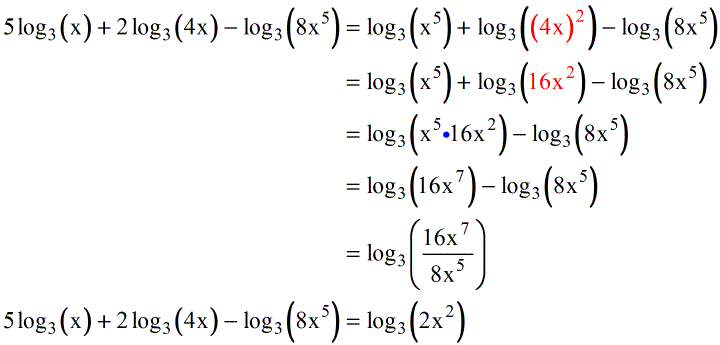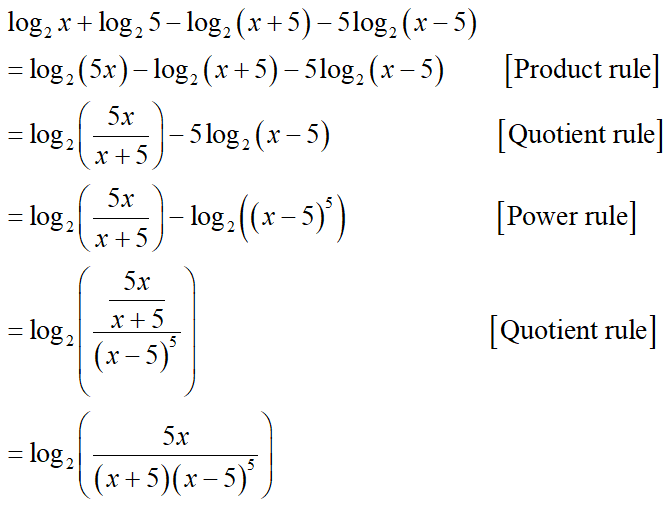
That way, we obtain formulas for adding logs, subtracting logs, and multiplying logs by a number. However, if we look at them backward, they write the expression as a single logarithm. The logarithm of an exponent is a multiple of a logarithm.Īs you can see, all of them take a single log (of a product, quotient, or exponent) and expand it into a longer expression.The logarithm of a quotient is a difference of logarithms.The logarithm of a product is a sum of logarithms.Still, let us see them in their original form. We often use them for expanding logarithms, but there's no harm in working them the other way round: for condensing logs instead. We will, however, use here three other formulas. If you'd like to see the specifics, make sure to check out Omni's dedicated change of base calculator. It allows us to switch from one log basis to another, but at a price - we get a quotient of two expressions from a single one. Let us begin by mentioning one log property that our condense logarithms calculator doesn't use - the change of base formula. Therefore, it should come as no surprise that the properties of the two are quite connected: in particular to multiplying and dividing exponents. We'll take on some gruesome expressions that involve logs and learn to write the expressions as a single logarithm.Īs we've mentioned in the first section, logarithms are the inverse operation to exponents. It's time to get back to mathematics and try simplifying logs using concrete formulas. Also, quite a few physical units are based on logarithms, for instance, the Richter scale, the pH scale, and the dB scale.Īlright, that should be enough of a description for now. Outside of mathematics, they're used in statistics (e.g., the lognormal distribution), economics (e.g., the GDP index), medicine (e.g., the QUICKI index), and chemistry (e.g., the half-life decay). After all, whatever we raise to power 0, we get 1. Whatever the base, the logarithm of 1 is equal to 0.In other words, whenever we write logₐ(b), we require b to be positive. The logarithm function is defined only for positive numbers.There is also the binary logarithm, i.e., log with base 2, but it's not as common as the first two. We denote them ln(x) and log(x) (the second one simply without the small 10), and their bases are, respectively, the Euler number e and (surprise, surprise!) the number 10. There are two very special cases of the logarithm which have unique notation: the natural logarithm and the logarithm with base 10.
CONDENSE LOGARITHMS EXPRESSION HOW TO
For example: ³√64 = 4īefore we learn how to rewrite logs, let's mention a few critical facts concerning them. However, as opposed to logarithms, roots return the exponent base, not the exponent itself (in the above language: they return how many people get infected by a single person).

Note that taking a root is also considered an inverse operation to taking a power. In the above epidemic example, the logarithm (with base 4) returns at which step we get a fixed number of infected. Note, however, that in general, this can be (calc:1503). 💡 logₐ(b) gives you the power to which you'd need to raise a in order to obtain b. To make it all precise, let's see the following log definition.

The logarithm is the inverse function to the exponential one. In general, we describe the number of sick in the n-th step by the exponent 4ⁿ. In turn, they got 4² = 4 * 4 = 16 people infected, who later got 4³ = 4 * 4 * 4 = 64 people infected. Indeed, if we assume that each infected person transmits the disease onto, say, 4 others, then patient zero got 4 people sick. Mathematically speaking, such a thing is called exponential growth.Īs you might have noticed, the name suggests that it has something to do with exponents.

With the COVID-19 pandemic raging on, there's been quite some talk about the rate at which the number of cases increases over time.


 0 kommentar(er)
0 kommentar(er)
